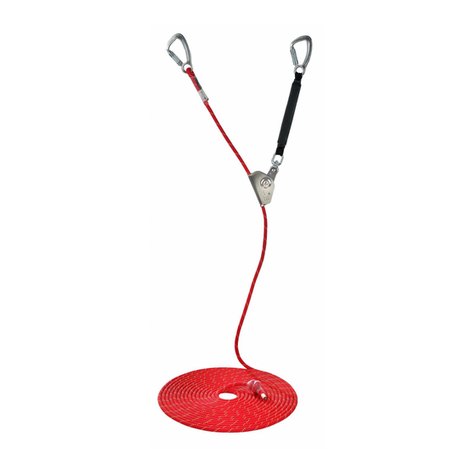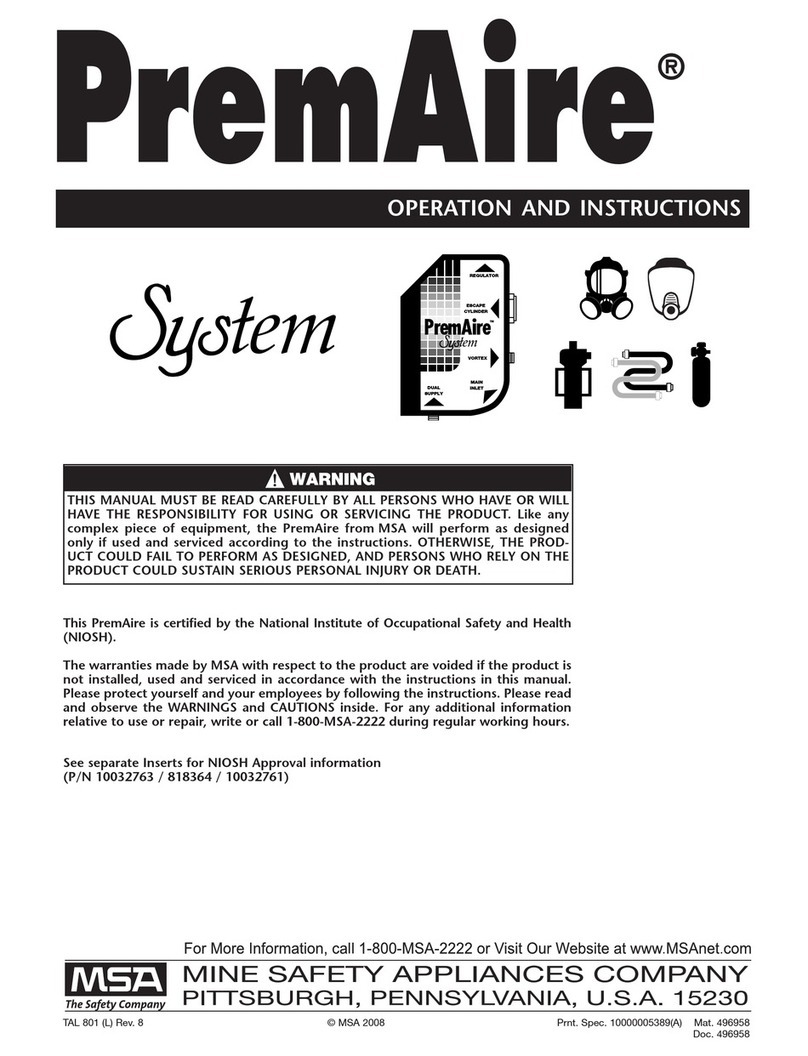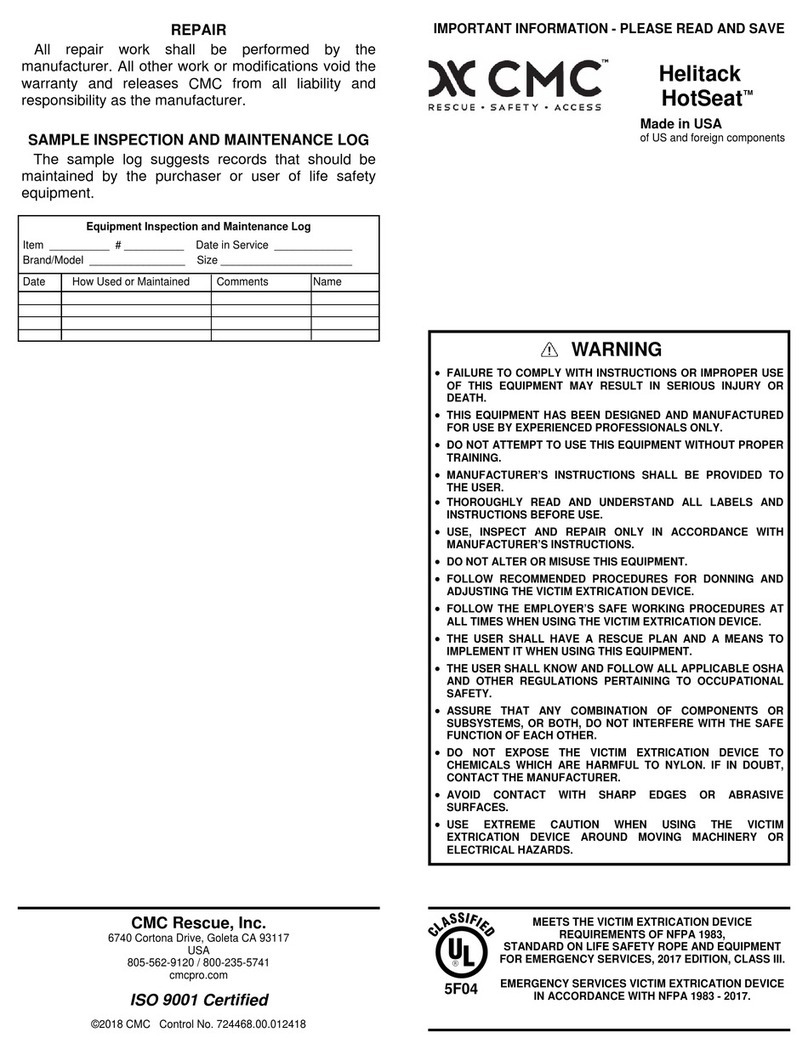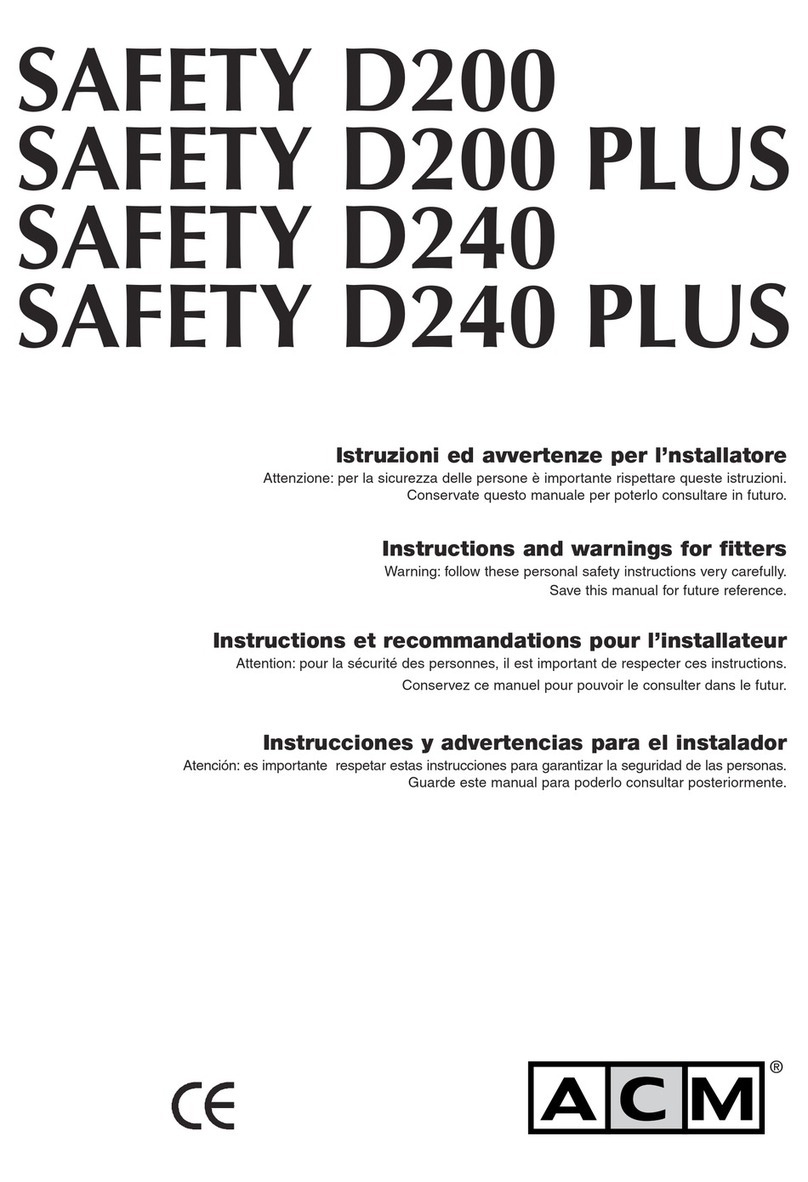GEV FlammEx FPL 4306 User manual

Verhaltensweise:
• Bewahren Sie Ruhe
• Überzeugen Sie sich von der Stabilität des Befestigungs-/
Anschlagpunktes und besteigen Sie dann erst die Leiter
• Steigen Sie möglichst in gestreckter Körperhaltung ab
• Halten Sie sich gut an den Sprossen fest und treten Sie möglichst
mit dem Mittelfuß auf. Steigen Sie wie folgt ab:
Paßgang:
rechter Fuß + rechte Hand, linker Fuß + linke Hand
oder Kreuzgang:
rechter Fuß + linke Hand, linker Fuß + rechte Hand
• Untenstehende Personen könnten die Leiter zusätzlich festhalten, um den
Abstieg zu erleichtern
• Bei mehreren Personen sollte der Abstieg nacheinander erfolgen
Zusammenlegen:
Legen Sie die Rettungsleiter der Länge nach auf den Fußboden. Halten Sie
die erste Sprosse fest und drehen sie die zweite Sprosse um 180° nach rechts.
Dann die nächste Sprosse um 180° in die entgegengesetzte Richtung. Die
darauf folgende Sprosse wieder um 180° in die andere Richtung. So verfahren
Sie bis zur letzten Sprosse.
Anschließend drücken Sie die Sprossen leicht zusammen und fixieren die
Rettungsleiter mit der Halteklammer.
Hinweise:
• Seilleitern müssen gegen schädliche Einwirkungen geschützt werden
• Schadhafte Seilleitern dürfen nicht benutzt werden
• Achten Sie vor dem Gebrauch auf Eignung und ordnungsgemäße
Beschaffenheit der Seilleiter
• Beachten Sie die Gebrauchsanleitung
Sprossenabstand dabei straff halten. Drehen um 180° nach rechts,
Drehen um 180° nach links usw.
Richtige Platzierung der Seile im
Profil. Halteklammern durch leichtes
Zusammendrücken der Sprossen
aufsetzen.
Sprossen einzeln oder bündelweise
auseinanderfalten. In gestreckter Haltung absteigen.
Handhabung:
Suchen Sie nach einem stabilen Einhänge-Anschlagpunkt zum Befestigen
der Leiter für den sicheren Abstieg. Balkon, Brüstungen, Dachvorsprünge
oder stabile Heizungsrohre bieten in der Regel einen guten Halt. Wenn
keine Befestigungsmöglichkeit vorhanden ist, muss eine Wandhalterung (als
Zubehör erhältlich) am Mauerwerk angebracht werden.
Wandhaken (Stahlhaken) an einen
stabilen Anschlagpunkt einhaken. Halteklammer durch leichtes
zusammendrücken der Sprossen
lösen.
Gutkes GmbH
Rehkamp 13
30853 Langenhagen
Deutschland
Fax: +49(0) 511 / 958 58 05
www.gev.de
service@gev.de
In einem Brandfall rechtzeitig durch FlammEx Rauchmelder gewarnt
werden und sich im Notfall retten können.
Wenn nur noch die Flucht durch das Fenster oder über den Balkon bleibt, weil
die Fluchtwege unzugänglich sind und die Feuerwehr noch nicht vor Ort ist,
dann hilft eine FlammEx Rettungsleiter.
Eine universell einsetzbare Rettungsleiter, gefertigt in Anlehnung an die
aktuellen Normen, BGI 638 (bisher ZH 1/368) aus feuerfestem, hochwertigen
Aluminium mit einem integrierten Wandhaken (Stahlhaken) für den schnellen
und einfachen Einsatz - der schnelle und sichere 2. Rettungsweg.
Lieferbare Typen:
• Länge 5 m (für ca. 2 Stockwerke)
• Länge 8 m (für ca. 3 Stockwerke)
D
Für den Fluchtweg über Balkone,
Brüstungen oder Dachvorsprünge.
Einsatz überall dort, wo die
Rettungsleiter nicht direkt auf einer
Fassade oder Mauer anliegt.
FPL # 004115
FPL # 004306
Rettungsleiter
004115.0001.120322-03/2012 UW

Behaviour:
• Keep calm
• Make sure that the attachment point is stable before climbing onto the
ladder.
• Climb down the ladder keeping your arms and legs as extended as
possible
• Hold tightly onto the rungs and climb down the ladder, placing the
centre of your foot onto each rung. Climb down as follows:
Feet and hands moving in unison:
right foot + right hand, left foot + left hand
or alternating feet and hands:
right foot + left hand, left foot + right hand
• People on the ground can hold onto the ladder to keep it steady and
make it is easier to climb down.
• Several people should climb down the ladder one after the other.
Folding together:
Lay out the rescue ladder lengthwise on the floor. While holding the first
rung, turn the second rung 180° to the right.
Then turn the next rung 180° in the opposite direction. Turn the next rung
180° in the opposite direction. Continue in this way up to the last rung.
Then gently press the rungs together and fix the rescue ladder in place using
the fixing clip.
Note:
• Protect the rope ladder from damage
• Do not use the rope ladder if damaged
• Before using the rope ladder, check that it is suitable for use and in
good
condition
• Follow the user instructions
Keep the spacing between each
rung taught. Turn 180° to the right
then 180° to the left, etc.
Side view of correct rope position. Attach the fixing clip by gently
pressing the rungs together.
Installation:
Locate a stable attachment point on which to hang the rescue ladder for a
safe descent. Balconies, balustrades, sloping roofs or sturdy heating pipes
generally provide a firm hold. Where there is no other suitable means of
mounting, the wall-mounted holder (available as an accessory) will need to
be mounted on the brickwork.
Unfold each rung individually or in
a bundle. Climb down keeping your arms and
legs extended.
Hook the steel wall hook over a
stable attachment point. Release the fixing clip by gently
pressing the rungs together.
For an escape route via a balcony,
balustrades or sloping roof.
For use in any position where the
rescue ladder cannot be directly
attached to a wall.
In the event of fire, be warned in plenty of time by FlammEx smoke
detectors so that you can make your escape.
If the emergency exits are blocked and the fire service has not yet arrived, a
FlammEx rescue ladder provides an escape route when the only way out is
through a window or over a balcony.
Tested to current standards (BGI 638 - previously ZH 1/368), the universal
rescue ladder is made of fire-proof, high-quality aluminium and is fitted with
an integrated (steel) wall hook for quick and easy use to ensure a fast and
safe alternative emergency exit.
Available types:
• Length 5 m (for approx. 2 floors)
• Length 8 m (for approx. 3 floors)
GB
FPL # 004115
FPL # 004306
Rescue ladder
Gutkes GmbH
Rehkamp 13
30853 Langenhagen
Germany
Fax: +49(0) 511 / 958 58 05
www.gev.de
service@gev.de
004115.0001.120322-03/2012 UW

Marche à suivre:
• Gardez votre sang froid.
• Avant de monter sur l’échelle, assurez-vous de la stabilité du point de
fixation/suspension.
• Descendez en vous tenant aussi droit que possible.
• Tenez-vous bien aux barreaux et posez-y de préférence vos pieds vers le
milieu de la voûte plantaire. Pour descendre, procédez de la façon
suivante:
Descente symétrique :
pied droit + main droite, pied gauche + main gauche
ou descente asymétrique :
pied droit + main gauche, pied gauche + main droite
• Les personnes se situant en bas de l’échelle peuvent tenir cette dernière
de sorte à faciliter la descente
• Si vous êtes plusieurs, empruntez l’échelle l’un après l’autre
Pliage:
Déployez l’échelle de secours sur le sol. Tenez fermement le premier barreau
et tournez le deuxième de 180° vers la droite.
Puis tournez le barreau suivant de 180° dans le sens opposé, et ainsi de suite
jusqu’au dernier barreau.
Pour finir, rassemblez doucement les barreaux et attachez l’échelle de secours
au moyen du clip de maintien.
Remarque:
• Les échelles de corde doivent être protégées des différents facteurs de
dégradation
• N’utilisez pas d’échelle de corde endommagée
• Avant de vous servir d’une échelle de corde, vérifiez son bon état et son
aptitude à être utilisée
• Veuillez suivre le mode d’emploi
Maintenir fermement l’écart entre les
barreaux Tourner de 180° vers la droite
puis de 180° vers la gauche, etc.
Positionnement adéquat des cordes
dans le profil Poser le clip de maintien en serrant
légèrement les barreaux
Déplier les barreaux un à un ou de
façon groupée. Descendre en se tenant droit.
Utilisation:
Cherchez un point de fixation solide où suspendre l’échelle pour que votre
descente se fasse en toute sécurité. Les balcons, balustrades, avancées de
toit et conduites de chauffage stables constituent généralement de bons
appuis. Si aucune possibilité de fixation ne s’offre à vous, un support mural
(accessoire) doit être monté sur la façade du bâtiment.
Accrocher le crochet mural (en acier)
à un point de fixation stable. Défaire le clip de maintien en serrant
légèrement les barreaux.
En cas d’urgence ou de déclenchement d‘un détecteur de fumée
FlammEx, s’échapper à temps peut être une question de vie ou de
mort. Si la fenêtre ou le balcon est la seule issue accessible et que les
pompiers ne sont pas encore arrivés, une échelle de secours FlammEx est
alors d’une aide inestimable.
Cette échelle de secours universelle est conforme à la norme allemande BGI
638 (anciennement ZH 1/368), composée d’aluminium de qualité supérieure
non inflammable et dotée d’un crochet intégré (en acier) pour une utilisation
ultra-simple - vous bénéficiez ainsi d’un dispositif d’évacuation fiable et
rapide.
Versions existantes:
• Longueur de 5m (pour env. 2 étages)
• Longueur de 8m (pour env. 3 étages)
F
Pour s’échapper par un balcon, une
balustrade, une avancée de toit.
S’utilise partout où les échelles de
secours ne peuvent pas s’appuyer
directement contre une façade ou un
mur.
Échelle
de secours
FPL # 004115
FPL # 004306
Gutkes GmbH
Rehkamp 13
30853 Langenhagen
Allemagne
Fax: +49(0) 511 / 958 58 05
www.gev.de
service@gev.de
004115.0001.120322-03/2012 UW

Indicazioni per un uso corretto:
• Cercare di mantenere la calma
• Verificare la stabilità dei punti di fissaggio e, solo a questo punto,
utilizzare la scala
• Scendere mantenendo possibilmente una postura allungata
• Tenersi saldamente ai pioli e poggiare bene l’intera pianta del piede.
Scendere lungo la scala come segue:
Movimento parallelo:
piede destro + mano destra, piede sinistro + mano sinistra
Movimento incrociato:
piede destro + mano sinistra, piede sinistro + mano destra
• La scala può essere mantenuta in posizione anche da chi si trova sotto
di essa, in questo modo la discesa risulterà semplificata
• La scala può essere utilizzata da una persona alla volta
Predisposizione all‘uso:
Stendere completamente la scala di salvataggio sul pavimento. Tenendo in
mano il primo piolo, ruotare il secondo di 180° verso destra.
Ruotare quindi il piolo successivo di 180° in senso opposto. Il piolo
successivo deve essere ruotato ancora una volta di 180° in senso opposto.
Attenersi a questa procedura fino all’ultimo piolo.
Infine, comprimere leggermente i pioli e bloccare la scala di salvataggio con
il fermaglio di fissaggio.
Indicazioni:
• Proteggere le scale a corda da eventuali danni
• Non utilizzare scale difettose
• Prima dell’uso, verificare la completa idoneità e integrità della scala a
corda
• Attenersi alle istruzioni per l’uso
Assicurare che la corda tra i pioli sia
in tensione. Ruotare di 180° verso destra,
quindi di 180° verso sinistra e
così via.
Posizionamento corretto della corda,
in sezione. Inserire i fermagli di fissaggio
comprimendo leggermente i pioli.
Ruotare i pioli uno per volta o
insieme. Scendere mantenendo una postura
allungata.
Installazione:
Individuare un punto stabile per appendere la scala in modo da poterla
utilizzare in tutta sicurezza. Balconi, parapetti, sporgenze del tetto e tubi
dell’impianto di riscaldamento stabili costituiscono in genere punti di fissaggio
ottimali. Se non è presente alcuna possibilità di fissaggio, è necessario
installare un supporto da parete (disponibile come accessorio) al muro.
Fissare i ganci da parete (in acciaio)
in un punto stabile. Rimuovere il fermaglio di fissaggio
comprimendo leggermente i pioli.
Per vie di fuga da balconi, parapetti e
sporgenze del tetto.
Utilizzare questo tipo di scala se la via
di fuga non si trova direttamente su
una facciata o un muro.
Durante un incendio, segnalato prontamente dal rilevatore di fumo
FlammEx, è fondamentale potersi mettere in salvo in tutta sicurezza.
Se le vie di fuga tradizionali sono bloccate e le uniche agibili restano la
finestra o il balcone, oppure se i vigili del fuoco non sono ancora giunti sul
posto, la scala di salvataggio FlammEx può rivelarsi estremamente utile.
Questa scala universale di salvataggio, omologata in base alle normative
attuali (come la BGI 638, fino ad oggi conosciuta come ZH 1/368) è realizzata
in alluminio di qualità, resistente al fuoco e dotata di ganci da parete integrati
(in acciaio) per un utilizzo semplice e rapido: una seconda via di fuga veloce
e sicura.
Tipologie disponibili:
• Lunghezza 5 m (per ca. 2 piani)
• Lunghezza 8 m (per ca. 3 piani)
I
Scala
di salvataggio
FPL # 004115
FPL # 004306
004115.0001.120322-03/2012 UW
Gutkes GmbH
Rehkamp 13
30853 Langenhagen
Germania
Fax: +49(0) 511 / 958 58 05
www.gev.de
service@gev.de
This manual suits for next models
3
Table of contents
Languages:
Popular Safety Equipment manuals by other brands
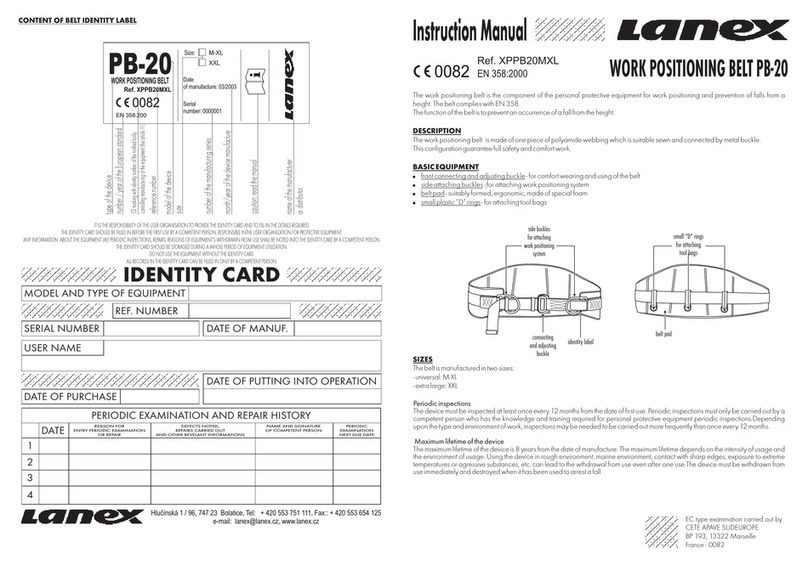
Lanex
Lanex PB-20 instruction manual
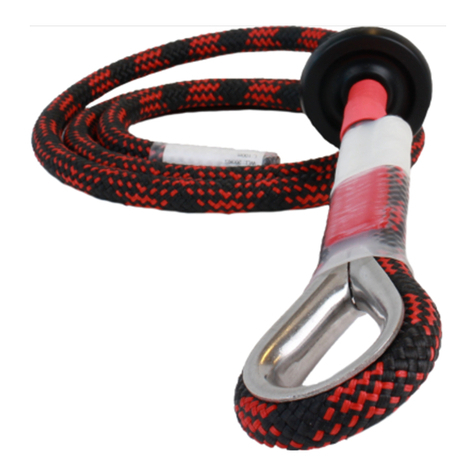
SKYLOTEC
SKYLOTEC ANCHOR ROPES Instructions for use

Besto
Besto Buoyancy Aid 50N Instructions for use

TEUFELBERGER
TEUFELBERGER NODUS Manufacturer's information and instructions for use

Troy Lee Designs
Troy Lee Designs Tbone Product owners manual
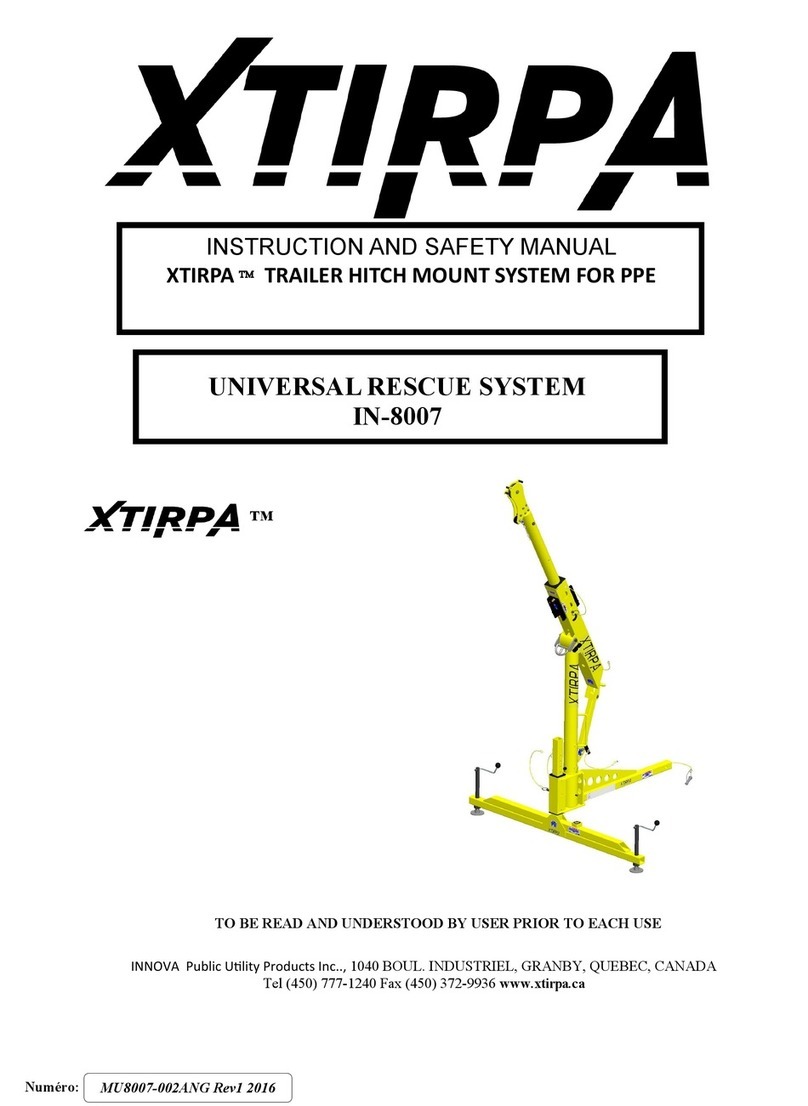
Innova
Innova Xtirpa Instruction and safety manual

bolle SAFETY
bolle SAFETY B810 quick start guide
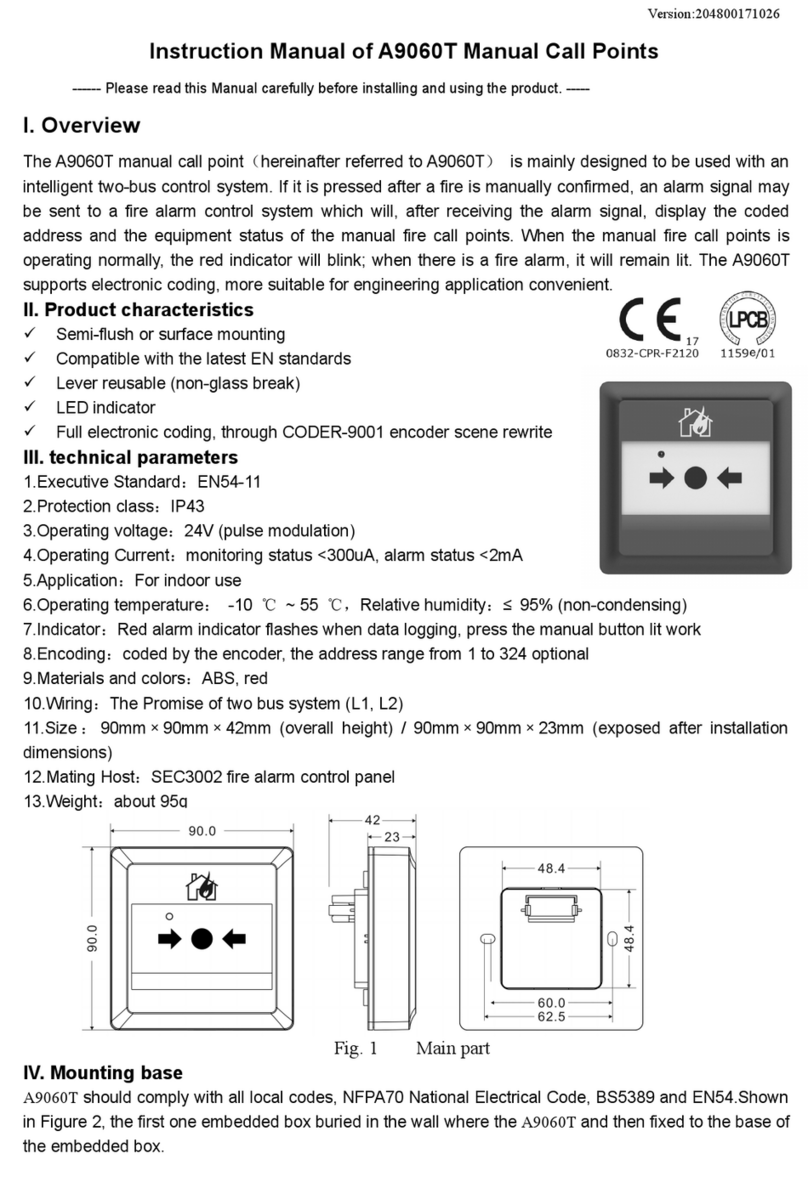
SHENZHEN FANHAI SANJIANG ELECTRONICS
SHENZHEN FANHAI SANJIANG ELECTRONICS A9060T instruction manual
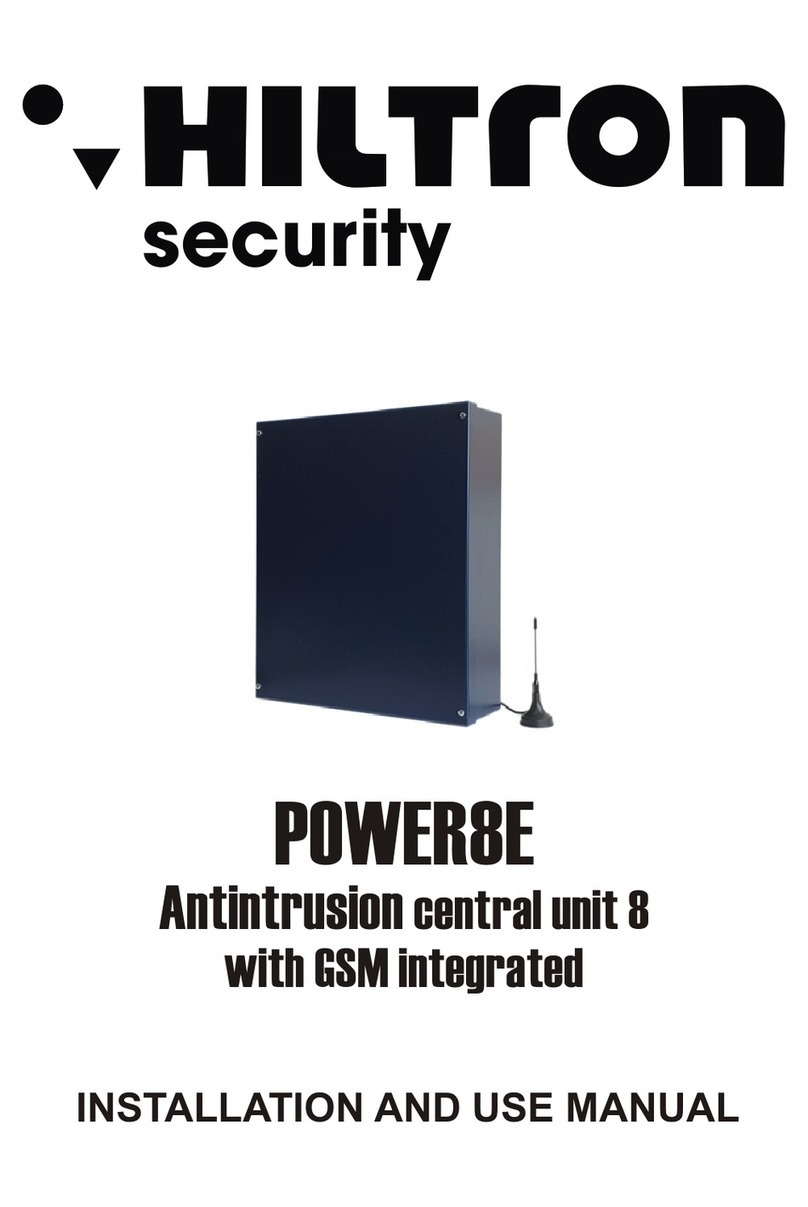
Hiltron security
Hiltron security POWER8E Installation and use manual

Salewa
Salewa MTN SPIKE user manual
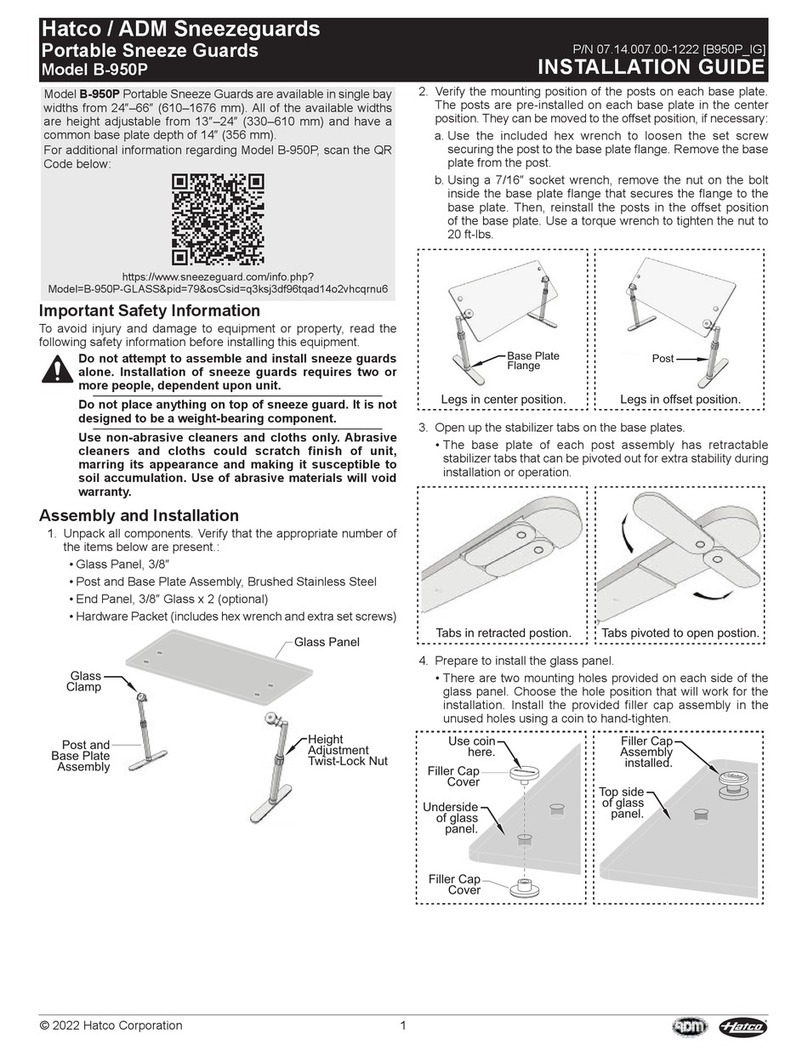
Hatco
Hatco B-950P installation guide
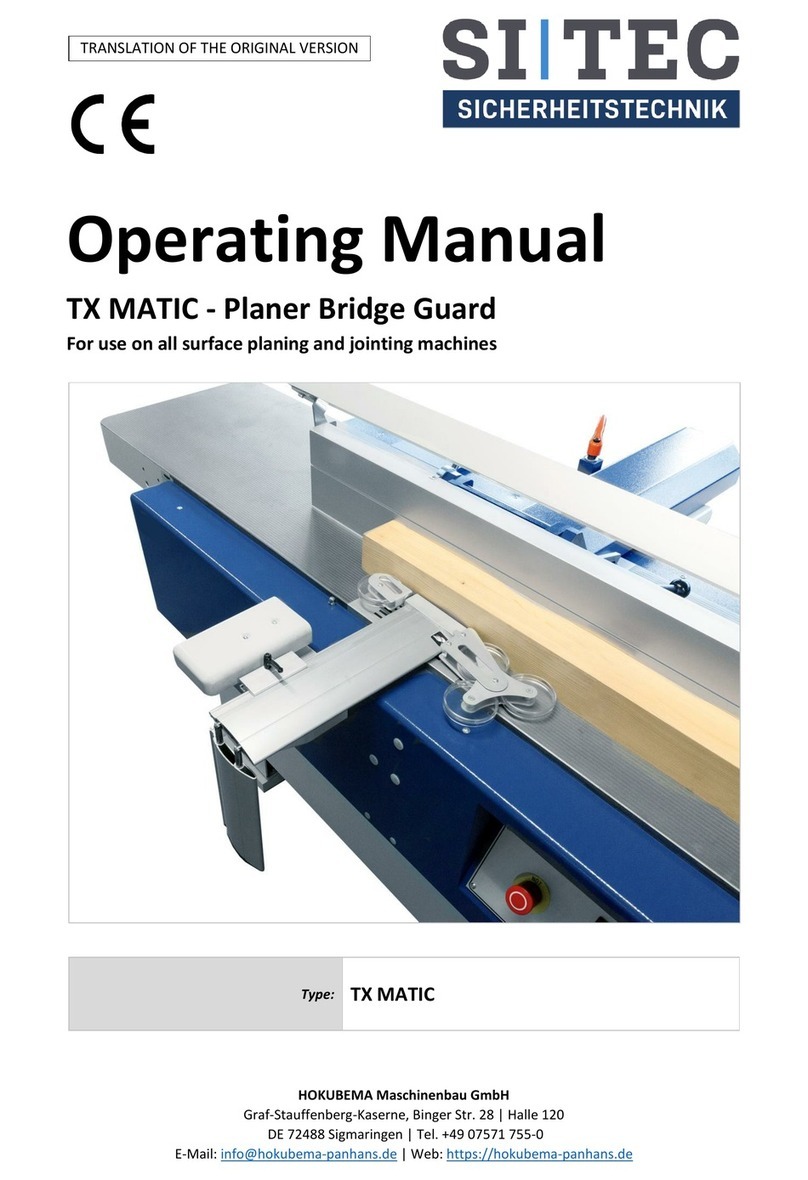
Sitec
Sitec TX MATIC operating manual
